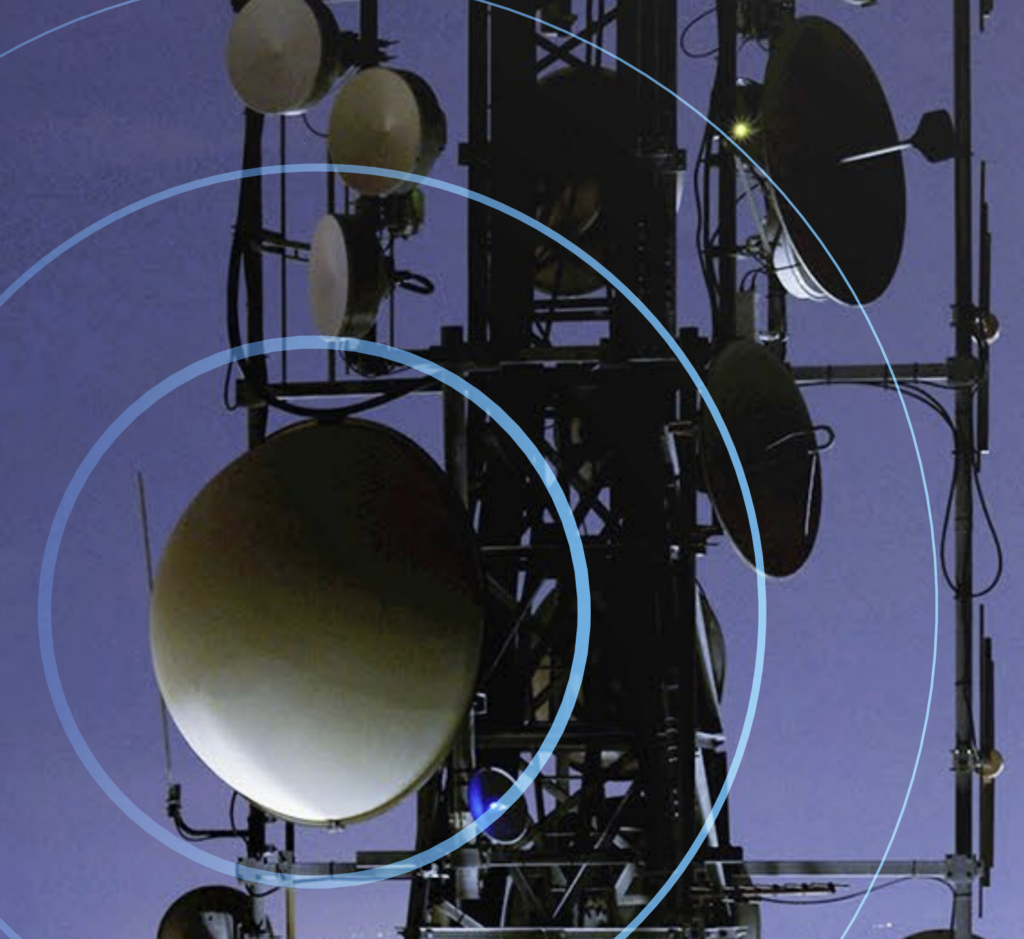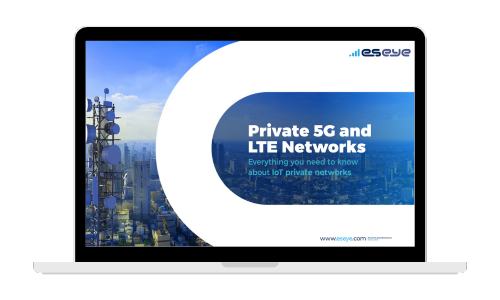

Could these networks give your IoT project a competitive edge?
Private LTE and 5G networks are now a viable alternative to Wi-Fi and proprietary network technologies such as LoRa: deployments are set to increase tenfold between 2021–2026.
Reliable, high-performance, and secure connectivity opens up a world of new opportunities and innovation, particularly for Industry 4.0 use cases and other IoT initiatives.
Today there are more than 1,000 private LTE networks deployed globally. With the advent of 5G, many enterprises are considering whether the features of 5G combined with the benefits of private networks could bring new competitive advantage.
The key for enterprises is to work out if there’s a compelling business case for deploying a 5G private network or if it’s just distracting hype

The benefits of cellular connectivity for IoT
In many IoT use cases, wired connectivity isn’t an option – for example, it isn’t feasible to cable devices that need mobility, are located in challenging environments or that are part of a massive deployment. With wireless networks, sites can be reconfigured without costly operations to move cables and equipment.
LoRaWAN® networks can provide low-cost connectivity for low bandwidth requirements but lack the security, robustness, and coverage of cellular networks. We compared the pros and cons of cellular and LoRaWAN® connectivity here.
Cellular technology can overcome many issues It meets the demands of many different IoT use cases, from battery-powered devices sending small amounts of data infrequently to devices that require predictable and consistent performance with extremely low latency or high bandwidth.
Although Wi-Fi is widely used for private networks and has low setup costs, this form of connectivity also comes with a few issues.
Cellular technology can overcome these issues. It meets the demands of many different IoT use cases, from battery-powered devices sending small amounts of data infrequently to devices that require predictable and consistent performance with extremely low latency or high bandwidth.
With wireless networks, sites can be reconfigured without costly operations… “
What is a private network?
Private LTE and 5G networks use the same technology that’s used for public networks and operate in licensed, unlicensed, or shared wireless spectrum. They use base stations, small cells, and other Radio Access Network (RAN) infrastructure to provide connectivity to devices such as routers, gateways, mobile phones and IoT devices. To connect, devices need a cellular modem capable of operating in the chosen spectrum bands and a SIM with a valid subscriber identifier for the network.
A private network is for the exclusive use of an enterprise. It may operate as a standalone network with no interoperability to other networks or it may be configured to switch to public networks if a device leaves the area of private network coverage.
Private network infrastructure handles the transfer of data between connected devices and the enterprise’s internal network, edge compute facilities and cloud services.
Why deploy a private network?
No public network coverage
Sites with no public network coverage in challenging environments, such
as mines, factories in remote areas and oil rigs, may not have the option of using
wired networks or Wi-Fi. If expensive equipment is involved, for example, autonomous guided vehicles in an opencast mine, the cost of providing a highly reliable, low latency network is justified by the risk of damage if connectivity fails.
Private networks can be installed on a temporary basis. For example, a mountain rescue team may deploy a private network on a remote hillside. Search dogs can be tracked, and sensors attached to an injured person can stream vital statistics to a doctor, enabling the rescue team to complete their mission quickly and safely.
High performance
Some solutions require extremely low latency or high bandwidth, for example, automated production lines, robotics, and autonomous vehicles. For these solutions, predictable performance is key – unexpected changes in latency or bandwidth can dramatically affect productivity or safety.
Configurability
MNOs configure the public networks to meet their business objectives and users’ needs. An enterprise can tailor a private network to meet its specific coverage, bandwidth, and latency requirements. It’s easier to add other functionality, such as additional security measures and integration with operational and business systems.
Data control
Data security, privacy or confidentiality requirements can impose constraints on transferring data to the cloud. And with edge processing, it may be unnecessary to send all IoT data to the cloud. A private network gives an enterprise total control over when and where data is transferred.
Security
A private mobile network is deployed at one or more of the enterprise’s sites and provides connectivity only for authorised devices, adding another layer of security to enterprise communications.
Security, data management, and privacy were ranked by enterprises as the highest driver when deploying private networks according to Omdia’s 2021 survey.
High density of connections
Some sites, such as high-tech factories and campuses, need a network that can support large numbers of connections. Using a public network could saturate local coverage and connections might experience unpredictable degradations in performance. The cost of subscriptions to public networks may be prohibitive.

…need a network that can support large numbers of connections.

Use cases for private networks
- Manufacturing plants and warehouses: Connecting Information Technology (IT) and Operational Technology (OT) systems and equipment to enable Industry 4.0 use cases that involve autonomous guided vehicles, robotics, production line quality control processes, preventative and predictive maintenance on machinery.
- Manufacturing plants and warehouses: controlling equipment, such as drilling machines and autonomous guided vehicles, in remote areas, challenging terrain, or underground.
- Transport hubs: enabling optimized processes in facilities such as airports and shipyards to perform automated security checks and asset tracking. Supporting the connectivity needs of employees, IoT devices, and passengers.
- Water and utilities: connecting to smart meters and other equipment, often located in challenging environments.
- Hospitals: connecting medical equipment, tracking assets, enabling remote healthcare.
- Retail stores, depots, campuses: providing fast, reliable, and secure connectivity to large numbers of people and devices.
5G – a step change in
connectivity capability
With 5G, MNOs can provide a network slice to enterprises requiring a private network. A network slice is a dedicated part of the MNO’s licensed spectrum and provides the advantages of a private network without the infrastructure investment or costs and complexity of operating a network.
Network slices can also be used within a private network to partition devices and applications. This enables enhancements for data security and containment, especially when combined with edge computing.
There’s more flexibility with 5G to configure the network to meet an enterprise’s needs.
For example, the uplink and downlink bandwidth ratios can be varied to meet specific requirements and aren’t limited by an MNO’s design choices for public mobile network users. This is important for 5G use cases, such as autonomous vehicles, for which video image processing requires far more uplink bandwidth than downlink.
LTE private networks can use unlicensed or licensed spectrum or a mixture of the two. 5G supports an expanded range of spectrum options, especially across licensed bands. This provides support for more diverse use case requirements.

Considerations for deploying private networks
Spectrum options
There are a number of options for the spectrum that private LTE and 5G networks can use:
Unlicensed spectrum is defined by the International Telecommunication Union (ITU) and is available for anyone to use, generally free of charge. Examples include the 2.4GHz and 5GHz bands used for Wi-Fi.
Licensed spectrum is mainly allocated to MNOs, who can give priority access or license segments of their spectrum to other end users.
Shared spectrum, such as the CBRS band in the US, is available for private networks, subject to specific country arrangements. Access to shared spectrum usually incurs some cost but not on the scale of buying licensed spectrum.
Use of radio spectrum is subject to country and operator specified regulations to prevent interference between networks and users. For example, transmit power spectral density (PSD) is severely constrained in the unlicensed spectrum.
Network interoperability
A key advantage of using an LTE or 5G private network is that interoperability with public networks is possible. For example:
In a campus environment, users may move in and out of the private network coverage as they enter and exit the campus, requiring connectivity to a public network when not on the campus.
A forklift truck in a factory might cross the road, moving out of the private network coverage and needing to switch to a public network.
In a connected supply chain, goods leaving the factory need to switch from the private network to a public network to enable asset tracking as they move to their destination.
In retail stores or depots, enterprises may have a number of independent private networks and require connectivity to a public network for vehicles and personnel traveling between sites.
Public networks can act as a backup in case a private network suffers an outage.
Providing interoperability between private and public networks is significantly more complex than operating a standalone private network.
For example, devices must support the different Radio Access Technology (RAT) types and spectrum bands that they might need to use with different networks.
For example, devices must support the different Radio Access Technology (RAT) types and spectrum bands that they might need to use with different networks.
The device must be designed to connect to the private network when in its coverage area and to a public network when it is outside that area.
For more advanced interoperability using a single SIM, a roaming agreement with an MNO is needed to enable devices to switch networks. With more advanced solutions, smart SIMs like Eseye’s AnyNet+ eSIM can store multiple subscriber identities and seamlessly switch between different networks to ensure optimum connectivity and competitive data rates.
A simple solution is to deploy dual SIM devices fitted with separate SIMs for private and public networks.
Data processing: edge, cloud, enterprise
Many use cases require edge compute to meet demands of latency, data security and privacy, bandwidth and power, availability, and reliability. Edge processing can be run on the device itself, on compute within the enterprise’s premises, or at the telecom edge.
The telecom edge refers to computing performed in data centers owned and operated by an MNO or other telecom operator. They can offer options from mini data centers located close to the enterprise to regional or national facilities with similar processing power to that available in the cloud.
Whether edge compute is used or not, there’s usually a requirement to transfer data to the cloud or on-premises facilities for storage, analytics, retraining machine learning models, or other processing.
A private network must be integrated with external systems and networks to enable data transfer to the target destinations with the latency and bandwidth required.
IoT platform
To effectively manage an IoT estate, enterprises must have centralized oversight of all the deployed devices. A sophisticated IoT platform – like Eseye’s Infinity IoT Platform™ – can manage existing and legacy SIMs, with the ability to optimize connectivity quality of service and price, device by device. Importantly, the IoT platform should help protect the IoT initiative’s long-term investment with the flexibility to add other wireless technologies as the market evolves.
Network design and infrastructure
A private network needs to meet the enterprise’s capacity and coverage requirements. The right number of antennas and masts must be located in the right positions, considering buildings, vegetation, and other factors that might impede connectivity. For more complex and challenging environments, experienced providers should perform a thorough site survey and network design.
Deploying a private network involves factors such as:
- Procuring and installing Radio Access Network (RAN) and core network computer equipment and software, unless outsourcing to a provider who can use existing infrastructure
- Configuring the network to provide the performance and security required and integrating with other systems, such as for edge and cloud computing
- Managing privacy, security, mobility, backup, software deployments and updates, storage, and compute resources
- Provisioning and deprovisioning IoT devices
- Testing devices, systems, and applications and obtaining any quality accreditations or certifications required
…beating that costly 80% failure rate for IoT projects.”

So, what’s the answer?
5G can drive innovation and growth by powering connectivity for IoT. Private networks offer levels of security, availability, and reliability that public networks can’t guarantee. Enterprises with use cases that demand 5G capabilities may also benefit from a private network. For example, the cost of a private network for a high-tech factory using robotics and automated production lines is justified by the potential losses in revenue if network performance degrades or is unpredictable.
And 5G (public or private) is not always the right solution. For example, 4G LTE easily meets the connectivity requirements for many use cases today, while for business cases relying on low-cost devices with low bandwidth, speed, and latency requirements, another technology such as 2G might be the best option.
Although cellular technologies are sophisticated and mature, deploying a private network to meet the connectivity requirements of an enterprise is complex and there’s no guarantee that it will generate ROI.
It’s critical to determine if deploying a 5G private network is justified before embarking on the initiative. The first step is to talk to a specialist in cellular connectivity who can provide independent, expert advice on the best solution to meet the enterprise requirements.
Looking to enhance your business with a Private 5G or LTE network? Contact us today to find the right solution for your IoT needs.
Maximize Your IoT with Private 5G and LTE Networks
Discover how a tailored private network solution can optimize your IoT deployment and drive your business forward.
⠀
⠀

